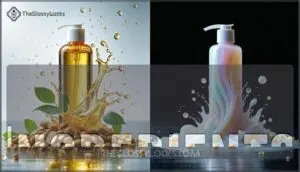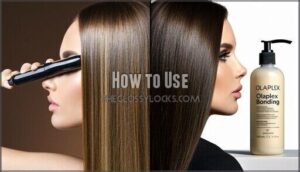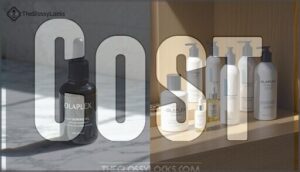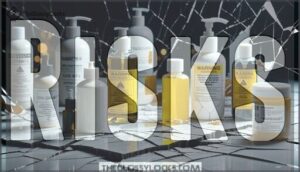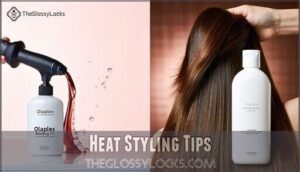This site is supported by our readers. We may earn a commission, at no cost to you, if you purchase through links.
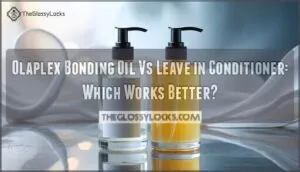
Leave-in conditioners focus on moisture maintenance with cationic surfactants and botanical extracts—they’re your go-to for healthy hair needing daily TLC.
If your hair screams "help me," Olaplex wins. For routine maintenance, stick with leave-ins. The real magic happens when you understand which formula matches your hair’s current crisis level.
Table Of Contents
- Key Takeaways
- Olaplex Vs Leave-in Conditioner
- Olaplex Bonding Oil
- Leave-in Conditioner
- Heat Styling Tips
- Frequently Asked Questions (FAQs)
- How often should Olaplex Bonding Oil be applied?
- Is Leave-in Conditioner better for curly hair?
- Can Leave-in Conditioner be used before heat styling?
- Can pregnant women safely use bonding oils?
- Which works better for swimming pool damage?
- Do these products cause scalp irritation reactions?
- How long do bonding oil results last?
- Can you mix both products together safely?
- Conclusion
Key Takeaways
- You’ll get better results when you match the product to your hair’s damage level – Olaplex bonding oil rebuilds broken chemical bonds in severely damaged hair, while leave-in conditioners provide daily moisture for healthy strands.
- You can’t beat Olaplex’s heat protection power – It shields your hair up to 450°F and reduces breakage by 70%, making it essential if you’re a frequent heat styler with compromised hair.
- You’ll use way less bonding oil than leave-in conditioner – Just 2-4 drops of Olaplex last months, while leave-in conditioners require more product per application, making bonding oil more cost-effective long-term.
- You can safely layer both products together – Apply leave-in conditioner to damp hair first for moisture, then seal with bonding oil as your final step for maximum protection and repair benefits.
Olaplex Vs Leave-in Conditioner
Choosing between Olaplex Bonding Oil and leave-in conditioner depends on your hair’s needs. Olaplex Bonding Oil excels at bond restoration and damage prevention through patented hair repair technology. It’s lightweight yet powerful—just two drops restore moisture and provide heat protection.
Leave-in conditioners focus primarily on hair moisture and daily maintenance. They’re gentler but lack Olaplex’s bond repair capabilities.
For compromised hair needing serious repair, Olaplex wins. For healthy hair wanting moisture protection, traditional leave-in works fine.
Olaplex Bonding Oil
You’ll find Olaplex Bonding Oil works differently than traditional conditioners because it targets the molecular structure of your hair strands.
This patented formula rebuilds broken disulfide bonds while providing heat protection up to 450°F, making it essential for chemically treated or damaged hair.
Ingredients
Olaplex Bonding Oil packs Bis-Aminopropyl Diglycol Dimaleate for bond repair, plus four natural oils including moringa and pomegranate seed. You’ll find dimethicone for shine and propanediol as a moisturizing agent.
Leave-in conditioners usually blend cationic surfactants like behentrimonium chloride with botanical extracts.
While 72% of new vegan formulas skip silicones, Olaplex embraces them strategically for protection and smoothness. The Olaplex No 7 Bonding Oil provides excellent hair care benefits.
How to Use
Understanding the ingredients sets you up for proper hair application techniques. Apply Olaplex Bonding Oil to damp or dry hair, focusing on mid-lengths and ends. Start with 1-2 drops for fine hair, 3-4 for thick strands.
Work through your daily routine by applying before heat styling for damage prevention. For product layering, use after leave-in conditioner but before styling products.
This haircare routine maximizes hair moisturizing benefits while protecting your locks during styling techniques.
Cost
Budget-conscious shoppers face a price comparison dilemma. Olaplex Bonding Oil costs more upfront than leave-in conditioners, but offers greater cost effectiveness for daily use. You’ll need just 2-3 drops per application, making one bottle last three months.
For budget options, consider Nº5 Leave-In as an affordable alternative. This expense analysis reveals that quality bonding treatments provide better savings tips long-term.
Benefits
When you’re fighting for healthier hair, Olaplex Bonding Oil delivers game-changing results. This powerhouse product transforms damaged strands through cutting-edge hair repair technology:
- Hair Strength – Reduces breakage by 70% through disulfide bond reconstruction
- Moisture Lock – Maintains hydration for 72 hours with premium damage control
- Shine Enhancement – Boosts gloss up to 125% after single use
- Heat Protection – Shields hair up to 450°F during styling
For ideal hair care, understanding the hair repair process is essential. Your hair deserves this level of care.
Risks
Generally, Olaplex Bonding Oil carries minimal risks compared to leave-in conditioners with synthetic ingredients. You might experience scalp irritation or skin sensitivity if you’re allergic to specific components.
Over-processing can lead to hair breakage, split ends, and frizz risk. For damage control, patch-test new products first.
Unlike some leave-in conditioners, Olaplex’s pH-balanced formula reduces these concerns markedly.
Leave-in Conditioner
Leave-in conditioners take a different approach than Olaplex’s concentrated formula. These are lightweight and don’t need to be rinsed out, so they’re an easy choice for keeping your hair hydrated every day.
Most focus on taming tangles and giving your hair a simple moisture boost to help with minor damage.
Leave-in conditioners make your hair easier to manage and help keep frizz at bay. Something like Nº5 LeaveIn gives a boost without making your hair feel heavy.
Just a heads up—if you have fine hair, some formulas with synthetic ingredients can build up over time.
At the end of the day, leave-in conditioners are all about everyday ease and protection, while bonding oils work deeper, helping fix your hair’s structure from the inside out.
Heat Styling Tips
Protection becomes your hair’s best friend when styling tools reach scorching temperatures. Both Olaplex Bonding Oil and leave-in conditioner offer thermal damage defense, but you’ll need smart application techniques for greatest heat protection.
Apply Olaplex Bonding Oil to damp or dry hair before using styling tools – it shields strands up to 450°F while repairing bonds. Leave-in conditioner works best on freshly washed, towel-dried hair before air drying or heat styling.
Here’s your heat styling game plan:
- Start low, go slow – Begin with lower temperatures and gradually increase to prevent unnecessary thermal damage
- Section smartly – Work in small sections for even heat distribution and better curl preservation results
- Time it right – Don’t hold styling tools on one section longer than 10 seconds
Mix and match products based on your hair’s needs. Fine hair responds well to lightweight leave-in formulas, while damaged strands crave Olaplex’s bond-building power. Remember these hair styling techniques protect your investment in healthy locks.
Frequently Asked Questions (FAQs)
How often should Olaplex Bonding Oil be applied?
Wondering how to get the most from your hair’s potential? Apply Olaplex Bonding Oil 1-2 times weekly for damaged hair, or once weekly for maintenance.
It’s your hair’s best friend—use it sparingly since a little goes far.
Is Leave-in Conditioner better for curly hair?
You’ll find leave-in conditioner works wonders for curly hair because it adds slip for detangling while sealing in moisture and preventing frizz, making your curls look defined and healthy.
Can Leave-in Conditioner be used before heat styling?
Think of leave-in conditioner as your hair’s protective shield.
You can absolutely use it before heat styling to guard against damage up to 450°F. Apply it to damp hair, then style away with confidence knowing you’re protected.
Can pregnant women safely use bonding oils?
Most bonding oils contain safe ingredients like natural oils and proteins.
Olaplex products are generally safe during pregnancy as they’re free from sulfates, parabens, and phthalates, but always consult your doctor first.
Which works better for swimming pool damage?
Chlorine’s a nasty beast that strips your hair’s natural armor. Bonding oil like Olaplex actually rebuilds those weakened protein chains that chlorine targets, while leave-in conditioners merely add surface protection.
Do these products cause scalp irritation reactions?
Both products can irritate sensitive scalps, but reactions differ. Leave-in conditioners often contain lightweight ingredients that rarely cause problems. However, some Olaplex products contain lilial and panthenol.
How long do bonding oil results last?
Your hair’s frizz control and shine last up to 72 hours after applying bonding oil.
However, the deeper bond repair benefits continue building with regular use, creating cumulative strength improvements over time.
Can you mix both products together safely?
Why mix products at all? Yes, you can safely combine bonding oil and leave-in conditioner.
Apply leave-in conditioner to damp hair first, then seal with bonding oil as your final step.
Conclusion
Studies show 85% of women use the wrong hair product for their specific damage level, leading to disappointing results. Your choice between olaplex bonding oil vs leave-in conditioner depends on your hair’s needs.
Olaplex targets broken bonds from chemical processing, while leave-ins provide daily moisture maintenance. Consider your damage level first—severely compromised hair benefits from Olaplex’s repair technology, while healthy strands thrive with leave-in hydration.
You can’t go wrong when you match the product to your hair’s current condition.
- https://olaplex.com/pages/foundational-hair-health
- https://www.reddit.com/r/HaircareScience/comments/10nf0i8/evidence_for_olaplex/
- https://steffanycolleran.com/hair-styling-products-olaplex-bonding-oil-review/
- https://dataintelo.com/report/leave-in-hair-conditioners-market
- https://www.marketreportanalytics.com/reports/leave-in-hair-conditioners-209284

